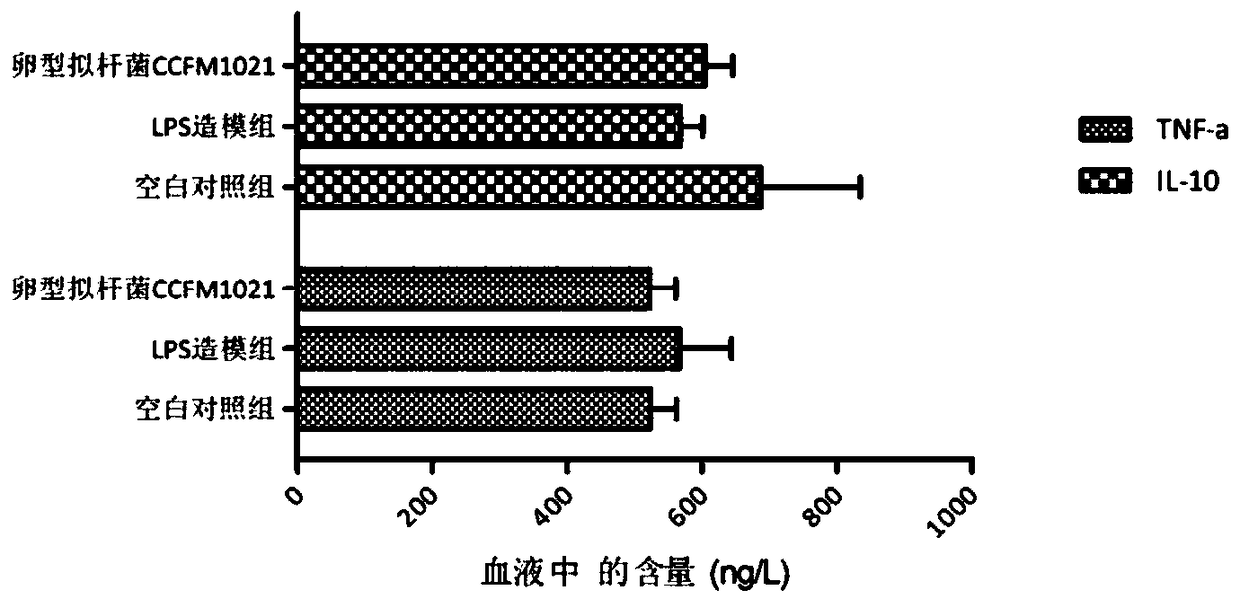Bacteroides ovatus for relieving endotoxin infection and application of bacteroides ovatus
A technology of Bacteroides ovale and Bacteroides, applied in the field of microorganisms, to achieve the effects of increased concentration, wide application prospects, and low immunogenicity
- Summary
- Abstract
- Description
- Claims
- Application Information
AI Technical Summary
Problems solved by technology
Method used
Image
Examples
Embodiment 1
[0045] The cultivation and storage methods of Bacteroides ovatus CCFM1021 are as follows:
[0046] Preparation of culture medium: Weigh brain-heart infusion BHI medium (such as the product of Qingdao Haibo Biotechnology Co., Ltd.) in proportion, dissolve it in distilled water, and add cysteine hydrochloride 1g / L, hemochloride Vegetables 0.01 g / L, vitamin K 10.002 g / L, mix evenly, then adjust the pH to 7.0, and sterilize at 115-121° C. for 15-20 minutes to obtain the culture medium.
[0047] Cultivation method: Bacteroides ovale CCFM1021 strains are inoculated according to the inoculum amount of 2-4% based on the weight of the above-mentioned culture medium, and anaerobically cultivated at 37°C for 12-18 hours, reaching a stable period.
[0048] Preparation of the protective agent: Weigh 1 g / L of cysteine hydrochloride and 200 g / L of glycerol, dissolve them in distilled water uniformly, and sterilize at 115-121° C. for 15-20 minutes to obtain the protective agent.
[0049]...
Embodiment 2
[0050] Embodiment 2: Tolerance dose experiment of Bacteroides ovale CCFM1021 gavage mice
[0051] Get 10 healthy female C57 mice of 6-8 weeks of age, the cryopreservation agent (10 10 CFU / ml), observed for 5 days, and recorded the body weight and death status of the mice.
[0052] The experimental results are listed in Table 1. These results indicate that feeding concentrations of 10 9 CFU of Bacteroides ovale CCFM1021 had no significant effect on the mice, with weight gain and no death. The appearance of the mice had no obvious pathological symptoms.
[0053] Table 1: Feeding 10 9 Effect of CFU of Bacteroides ovale CCFM1021 on body weight of mice
[0054]
Embodiment 3
[0055] Example 3: Immune tolerance experiment of mice fed with Bacteroides ovale CCFM1021
[0056] Twenty healthy female C57 mice aged 6-8 weeks were randomly divided into two groups: negative control group and Bacteroides ovale CCFM1021 intervention group, with 10 mice in each group. The mice of the Bacteroides ovale CCFM1021 intervention group were given 0.1ml of the above-mentioned Bacteroides ovale CCFM1021 cryopreservation agent once every 24 hours (10 10 CFU / ml), the mice in the control group were fed with 0.1ml of the protective agent of the above-mentioned cryopreservation agent every 24 hours, and all mice were sacrificed after 5 days of continuous gastric administration, and the blood and colon tissues were respectively collected and passed through RIPA lysate (Beiyuntian Biotechnology Co., Ltd. Technology Co., Ltd.) after lysing and homogenizing, the concentration of immune factors was determined using an ELISA kit (product of Nanjing Senbega Biotechnology Co., Ltd....
PUM
 Login to View More
Login to View More Abstract
Description
Claims
Application Information
 Login to View More
Login to View More - R&D
- Intellectual Property
- Life Sciences
- Materials
- Tech Scout
- Unparalleled Data Quality
- Higher Quality Content
- 60% Fewer Hallucinations
Browse by: Latest US Patents, China's latest patents, Technical Efficacy Thesaurus, Application Domain, Technology Topic, Popular Technical Reports.
© 2025 PatSnap. All rights reserved.Legal|Privacy policy|Modern Slavery Act Transparency Statement|Sitemap|About US| Contact US: help@patsnap.com



